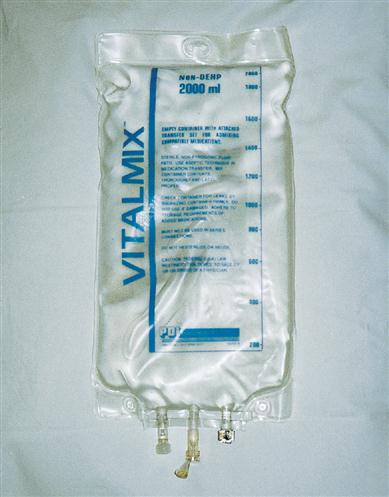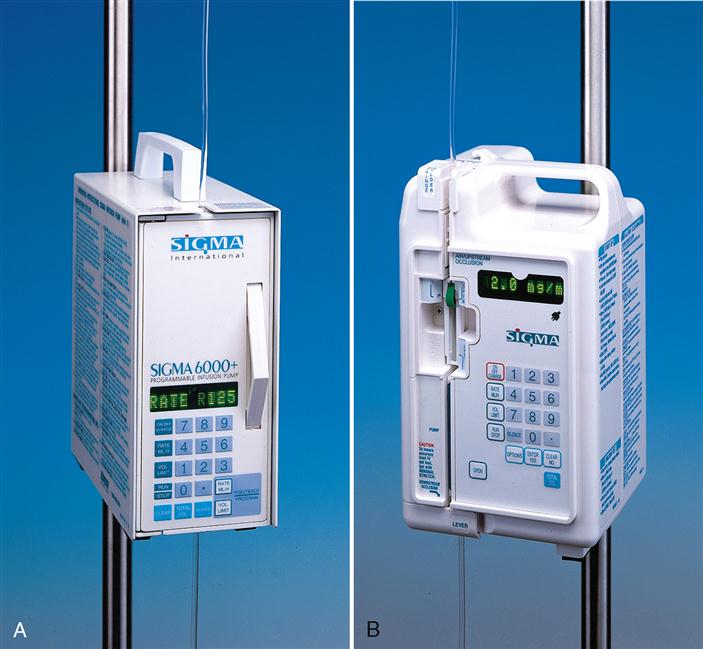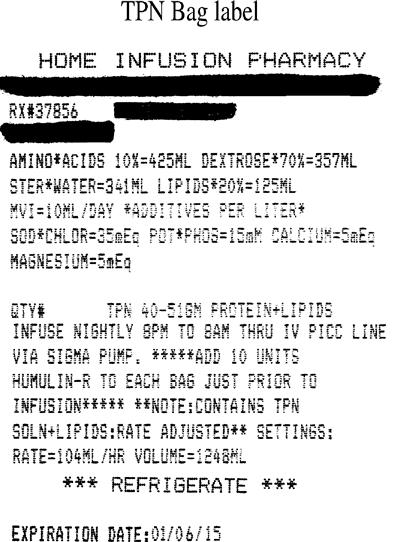Parenteral Nutrition
Objectives
• Calculate grams of protein, dextrose, and lipids per order.
• Calculate the percentage of protein, dextrose, and lipids per infusion.
• Calculate the percentage of additives per infusion.
• Calculate the kilocalories for protein, dextrose, and lipids per infusion.
• Calculate the total kilocalories per infusion.
• Compare the ordered amount of parenteral nutrition with the infusion label.
Introduction
The IV requirements for patients who are unable to ingest food are calculated on a daily basis. Concentrations of nutrients are calculated to show the differing strengths and percentages of additives for peripheral and central lines. The percentage of additives is calculated to ensure that the electrolyte and mineral requirements are being met. Standard orders for peripheral and central lines are compared. Medication administration records are discussed. The importance of parenteral orders and verification of the labels on the bag are stressed.
Total Parenteral Nutrition
Nutritional support of the sick patient in the hospital as well as in the home has become increasingly important. More people are being treated with total parenteral nutrition (TPN) in the home and it is the nurse’s responsibility to teach the patient and the family to care for the catheter insertion site, the infusion pump, and possible side effects of the infusion. Survival of the patient with a gastrointestinal problem is made possible by advances in the field of parenteral nutrition.
 CLINICAL ALERT
CLINICAL ALERT
Medication incompatibility can occur when IV medications are delivered with TPN administration. A TPN IV pharmacist should be consulted to determine compatibility.
TPN permits the venous administration of dextrose, amino acids, lipids, electrolytes, and vitamins to sustain life when the gastrointestinal system must be bypassed or during serious illness or injury (e.g., burns). A TPN bag is shown in Figure 9-1.
A routine maintenance IV solution of 1000 mL with 5% dextrose delivered over an 8-hour period provides approximately 200 calories derived from dextrose. If a patient is restricted from ingesting anything by mouth (npo) and receives 3 liters of D5W a day, the 600 total calories received would not be enough to promote or maintain health for a sustained period. In contrast, TPN may deliver as much as 1 cal/mL, depending on the concentration of nutrients.
TPN is administered via a central vein such as the subclavian or internal jugular. This is known as central parenteral nutrition (CPN). Peripheral administration, known as peripheral parenteral nutrition (PPN), is given via peripheral veins. The choice depends on the patient, the vein condition, and how long the patient will need the therapy. The larger central veins are selected for longer term therapy and higher concentrations of nutrients. The contents of TPN are customized according to the patient’s condition and need, the venous route, relevant laboratory values, and the patient’s weight. Orders for the contents may be changed daily. Special formulas are created for renal, hepatic, diabetic, burn and cardiac patients. TPN formulas are specific and are determined by energy, protein, fluid, and caloric requirements.
PPN is used for nutritional therapy of 2 weeks or less. A PPN solution must be kept at the following concentration levels to prevent vein irritation: amino acids, 5.5%; dextrose, 10%; lipids, 10%. CPN permits high levels of concentration because it is infused into large veins. CPN solutions are hypertonic and have high osmolarity. CPN is used when nutrition therapy is needed for longer than 2 weeks. CPN concentrations usually are as follows: amino acids, 8.5% to 15%; dextrose, 20% to 70%; lipids, 20%. Dextrose administered with amino acids spares the protein for tissue repair. Parenteral nutrition must always be administered by an infusion pump, never by gravity. There are many types of electronic delivery devices. Figure 9-2 shows two such devices.
A three-in-one solution, or total nutrition admixture, combines lipids, amino acids, and dextrose. The solution is white because of the lipids, which make precipitation difficult to observe. The three-in-one solution is used for both hospital and home therapy. When lipids are administered with dextrose and amino acids, the osmolarity of the solution will improve the tolerance for peripheral venous administration. The lipids can also be administered separately (Figure 9-3). Lipids help control hyperglycemia, which is a complication of parenteral nutrition. After 12 hours lipids may become unstable; therefore, monitor carefully. Lipids are isotonic and can therefore be administered either peripherally or centrally. If a fat embolus could be a problem, monitor the patient closely. Amino acids, vitamins, and other life supporting additives are easily denigrated when exposed to sunlight. Home therapy TPN is usually run for 12 hours to give the patient some infusion free time.
Validation of TPN Label With the Physician’s Order
Validate the contents listed on the TPN bag label (see Figure 9-5), with the physician’s order (Figure 9-6).
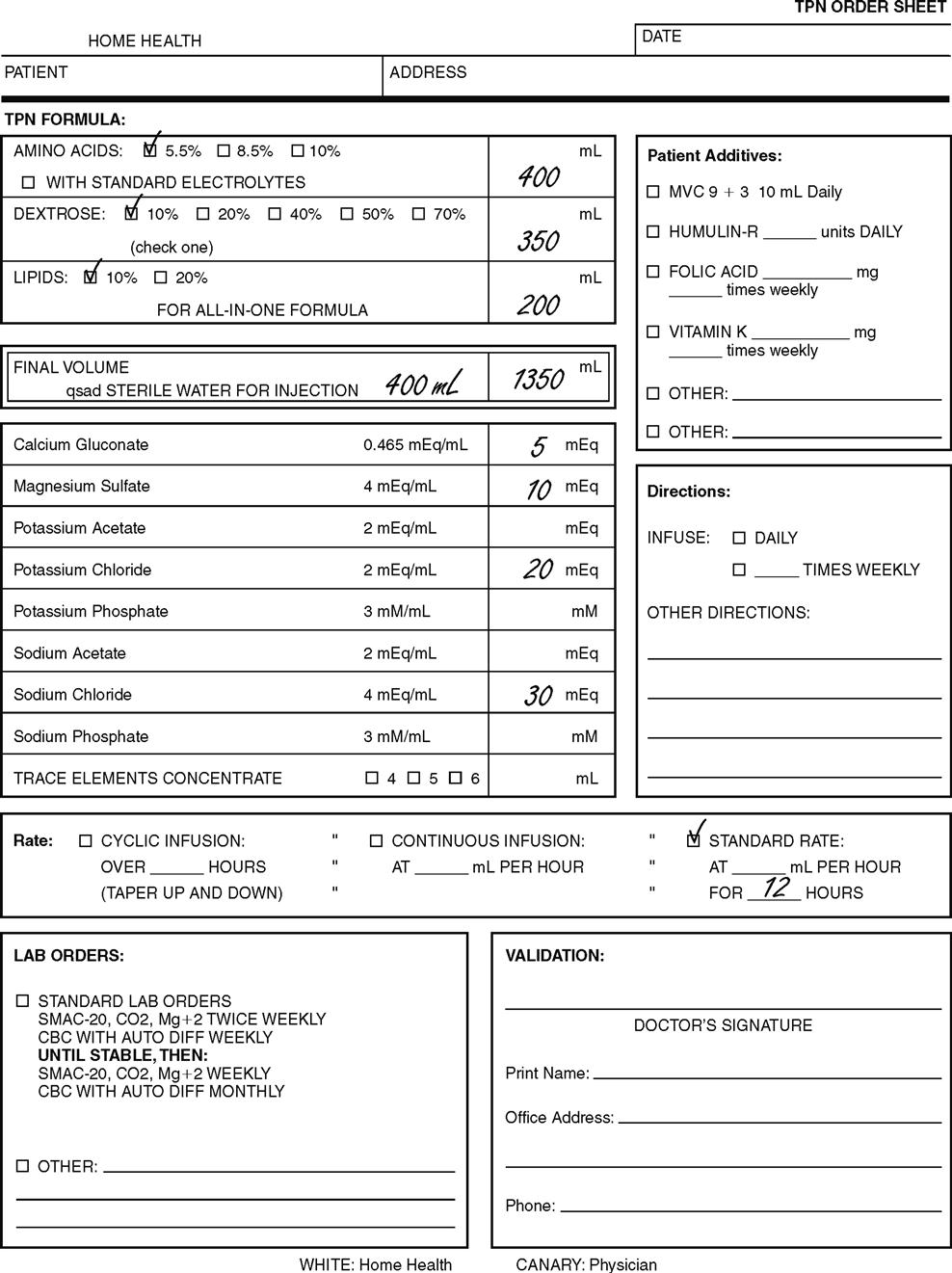
The 341 mL of qsad (quantity sufficient additive) sterile water includes the volume for the additives of calcium gluconate, magnesium sulfate, potassium phosphate, sodium chloride, and multivitamins. In this order, the pharmacist included all of the additives (except for the 10 units of insulin, which the nurse will add immediately before administration).
 CLINICAL ALERT
CLINICAL ALERT
The nurse’s responsibility is to check the physician’s order to determine if the pharmacy has filled the order according to the directions in Figure 9-4. Compare the order with the label (Figure 9-5).
Example
Refer to Figure 9-4, a sample physician’s order form.
 CLINICAL ALERT
CLINICAL ALERT
It is not recommended to administer other medications via the Y-port or piggy back before consulting with the pharmacist for compatibility. There can be many metabolic complications due to the type of additives in the TPN solution.
Calculate grams, percentage of concentration, and kilocalories per bag of TPN.
Total Grams Per Bag
| Formula: % × mL = g/L | Formula: g/L × TV*/L = g/bag |
| Stepl | Step 2 |
| Amino acids (AA) 10% in 425 mL | 42.5 g/L × 1.248 TV/L = 53 g/bag |
| 0.10 × 425 = 42.5 g/L | There are 53 g of AA in 1248 mL of TPN. |
Shortcut method: % × mL = g/L × TV/L = g/bag
AA 10% in 425 mL
0.10 × 425 = 42.5 g/L × 1.248 TV/L = 53 g
To calculate the answer for g/L, multiply by the TV to determine the total g/bag.
There are 55.5 g of AA in 1248 mL of TPN.
Shortcut method: % × mL = g/L × TV/L = g/bag
Dextrose 70% in 357 mL
0.70 × 357 = 250 g/L × 1.248 TV/L = 312 g/bag
To calculate the answer for g/L, multiply by the TV to determine the total g/bag.
There are 312 g of dextrose in 1248 mL of TPN.
Shortcut method: % × mL = g/L × TV/L = g/bag
Lipids 20% in 125 mL
Step 1 Step 2
0.20 × 125 = 25 g/L × TV/L 1.248 = 31.2 g/bag
There are 31.2 g of lipids in 1248 mL.
Percentage of Concentration Per Bag
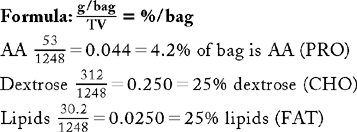
Percentage of Additives
| Formula: | Step 1 | mEq/L × TV/L = mEq/bag |
| Step 2 | mEq/bag −5-TV = % in bag | |
| Shortcut method: | mEq/L × TV/L/TV = % in bag | |
| Calcium gluconate | 5 mEq × 1.248 TV = 6.24 mEq/bag | |
| 6.24 + 1248 = 0.005 = 0.5% in bag | ||
| Magnesium sulfate | 5 mEq × 1.248 = 6.24 = 1248 = 0.5% in bag | |
| Potassium phosphate | 15 mEq × 1.248 = 18.72 + 1248/1.5% in bag | |
| Sodium chloride | 35 mEq × 1.248 = 43.68 = 1248/3.5% in bag |
Stay updated, free articles. Join our Telegram channel

Full access? Get Clinical Tree



